ANURADHA GOYAL
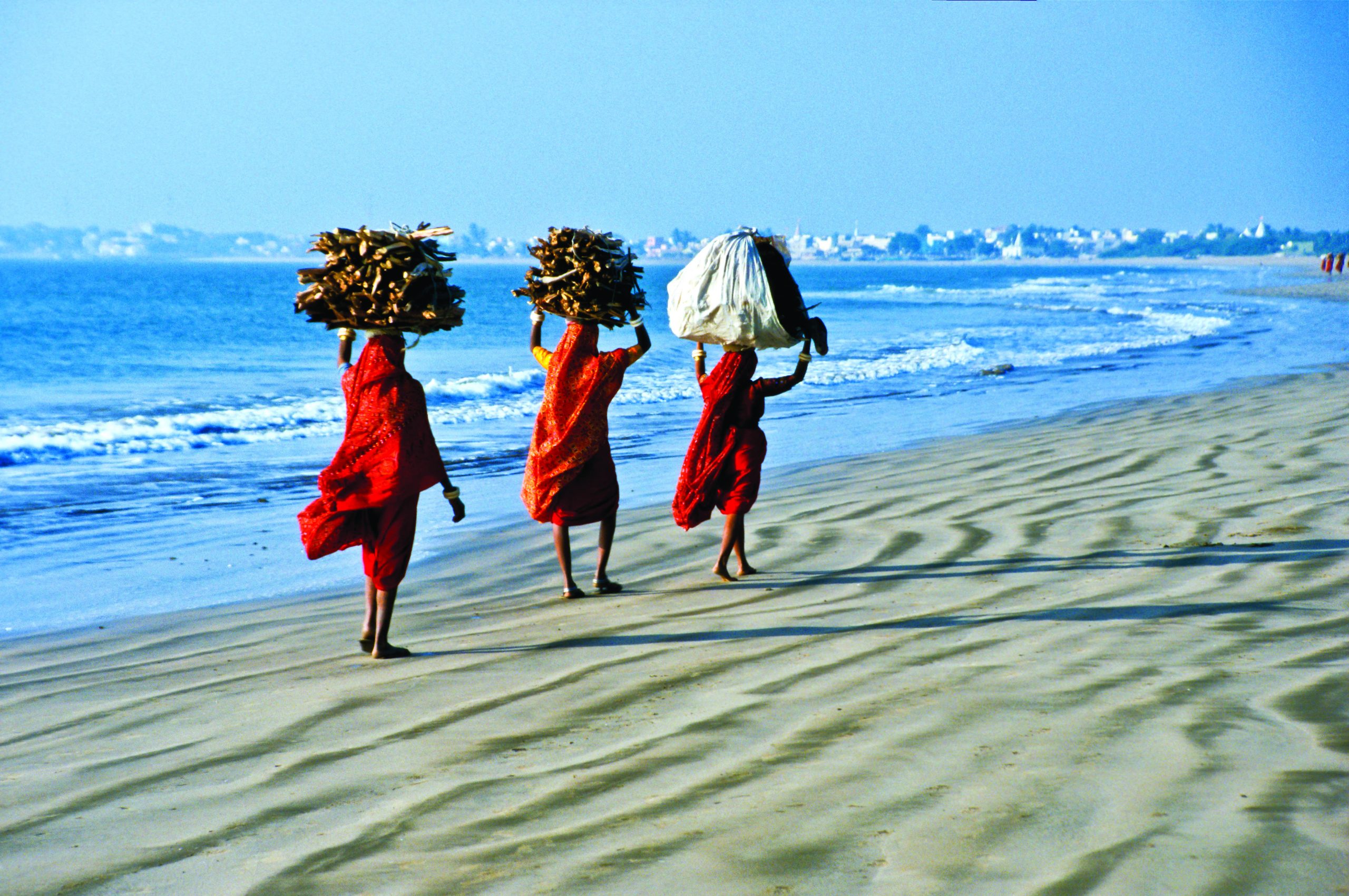 Daman is a small town on the west coast of India — sandwiched between the states of Maharashtra and Gujarat. But it has managed to establish to hold a niche identity for itself. Some of this identity is rooted in its past as it was a Portuguese colony along with Goa. You might remember the Union territory of Goa, Daman & Diu from your school textbooks.
Daman is a small town on the west coast of India — sandwiched between the states of Maharashtra and Gujarat. But it has managed to establish to hold a niche identity for itself. Some of this identity is rooted in its past as it was a Portuguese colony along with Goa. You might remember the Union territory of Goa, Daman & Diu from your school textbooks.
A contemporary identity of this union territory is that it’s a small island where you can drink alcohol unlike in the neighbouring dry state of Gujarat. In fact, this is a big reason for the Gujaratis to visit this Union territory. Especially over weekends and holidays.
The town is situated on both the banks of the River Daman Ganga that merges here with the Arabian Sea. Another way to look at it is that the town is divided into two parts by the river. Moti Daman on its Southern Bank and Nani Daman on its Northern Bank. Moti means big and Nani means small in Gujarati — a language that is mainly spoken in Daman (pop.59,000). The irony is that the Moti part is the smaller of the two, but it is older. It offers more for the history seeker. While the Nani part is for the business traveler and thrill-seekers in general.
I began my exploration with the Nani Daman as that is where I lodged at The Deltin.
Nani Daman
We started by visiting the Daman Ganga Estuary where on one side stands Saint Jerome Fort.
The tide was low so the boats seemed to be parked on sand. But I was told every evening Nani Daman witnesses the high tide and boats start floating. Across the waters, we could see a black and white watchtower standing like a lone sentinel keeping an eye on the sea.
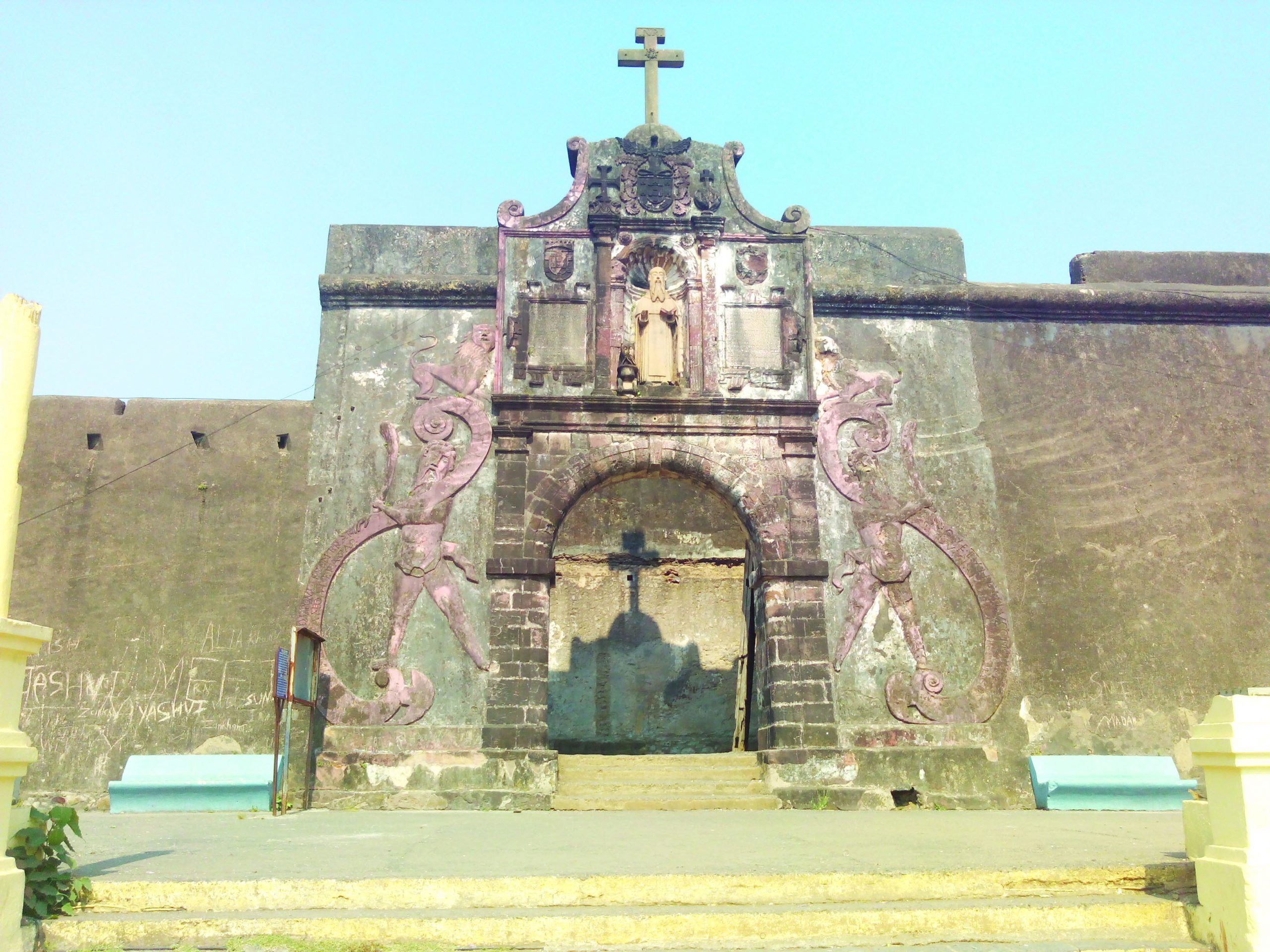 Fort Saint Jerome
Fort Saint Jerome
A tired-looking fort stands on the north bank of the Daman Ganga River. Its entrance has carvings on it with a cross on the top. I do not understand these icons or the stories behind them. But the inscriptions in Portuguese safely place this fort to the days when this place was a Portuguese colony. A splendid Statue of St Jerome stands on top of the entrance arch. History books tell us that this fort was built about four centuries ago. To keep an eye on the maritime activity in the Arabian Sea.
Our Lady of the Sea Church, St Jerome Fort
As soon as you enter the fort you see an open ground with the church in one corner, surrounded by the thick wall that wears an even thicker veneer of age. I chose to climb a staircase leading to the upper story that looked ike a rooftop from the ground floor. However, the view was not disappointing. There was a thick wall going around the ground. Wide enough for a few people to walk side by side and keep an eye on the area surrounding the fort.
There was small, random construction of which no documentation could be found.
Portuguese War Cemetery
As I climbed up, on the left was a reasonably well-maintained cemetery with a small shrine-like room. A flowering Gulmohar tree gently showered flowers on the graves. I would later learn this is a Portuguese war cemetery.
Flag post at Saint Jerome Fort
At one corner of the fort, I could see the rooms built around a small courtyard, but everything was locked, so you need to peep in and take guesses. My guess is that this may be the living quarters of the fort. I walked around the fort and came face to face with a platform on which stood a worn-out wooden flag post. I assume this must have been used to keep the flag flying high.
Towards the sea, there is an ice factory of government’s fisheries department but what intrigued me was the forsaken wooden boats lying all over the streets These are out-of-service boats and they have lots of stories to tell if only we can listen to them.
Today, the Fort of Saint Jerome is visited more than church of Our Lady of the Sea.
Samudra Narayan Temple
On the edge of the platform embanking the river stands a small but colorful temple dedicated to Samudra Narayan or the Varun Dev. He is reported to be the lord of the sea. This is the first time I saw a temple dedicated to him. One would assume there would be many temples dedicated to the Varun Dev or lord of the sea. But I do not recall a single one throughout the bits of the coast that I have traveled.
This one would have also escaped a normal eye but for its color and its near-isolated location on the edge of the land.
On a small patch of sand, temporary stalls made their presence felt with fluttering cloths.
As we drove through, I could see many old buildings. Every time I asked about them, I was told — Oh, that is just an old building – nothing to see. This part is the business heart of the town and has bustling bazaars, with vehicles moving all around. And in the middle stands a clock tower with three lights.
Devka Beach
Both the Damans have a beach to themselves, for Nani Daman, it is Devka Beach. Compared with the beaches of Goa, you would hardly call it a beach. Having said that I must admit at low tide this beach reveals its rocky bed. You can walk through the maze and you can choose a rock to sit on. While perched there, you see the sea receding and approaching the shore.
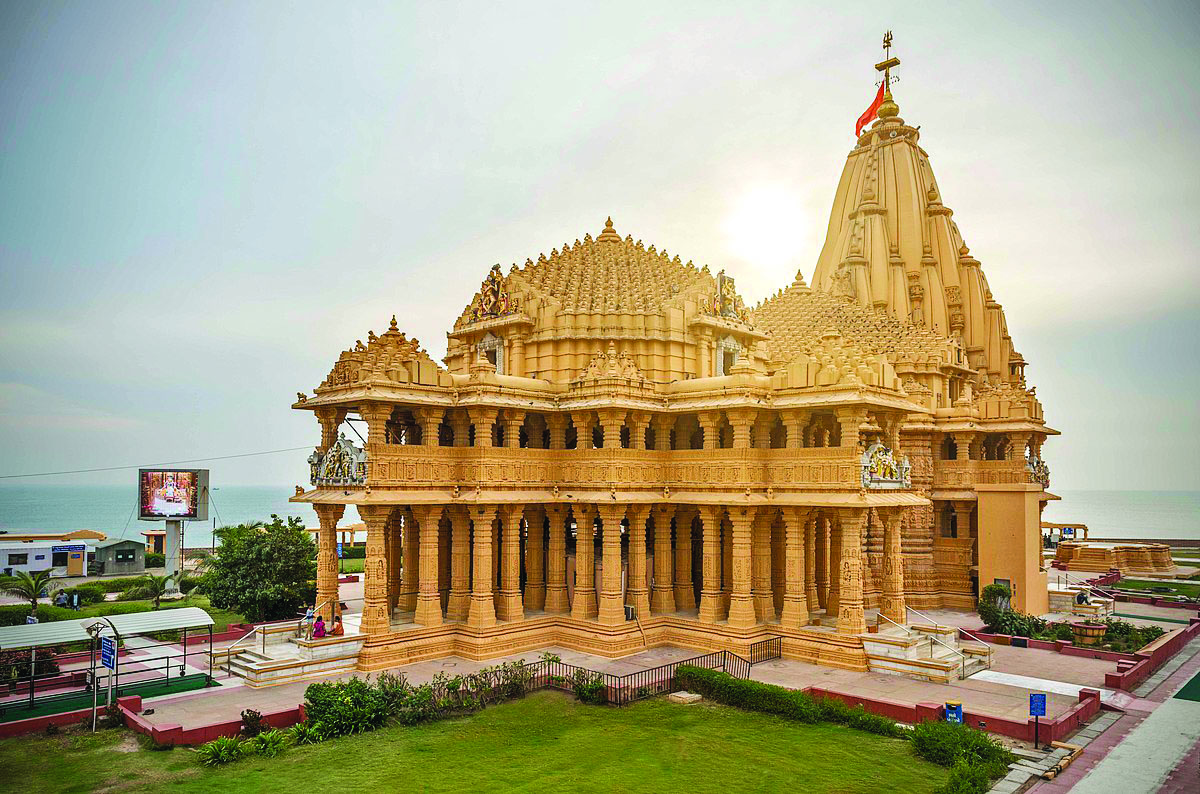 Somnath Mahadev Mandir
Somnath Mahadev Mandir
Somnath Mahadev Temple. This is a small white-colored temple, that looks as simple as a temple can. You have to step inside to see it shining and shimmering. The interiors are made of glass. I have seen many Jain temples with similar work on their ceilings, but this one is made of glass around. Worth a visit. No photography allowed, though.
Moti Daman
If you are a history buff, this is where you can spend some time. There is, of course, Jampore Beach that I had written about earlier. Cross the Daman Ganga River and on the other side, the fort dominates. This fort is still a living monument and most of its buildings function as government offices. This also means that they are out of bounds for the general tourist. You can admire them from the outside and move on.
The most visible part of the fort here is its massive wall that can be seen from the river. The most visible part is its gate that is still used to go in and out of the fort periphery.
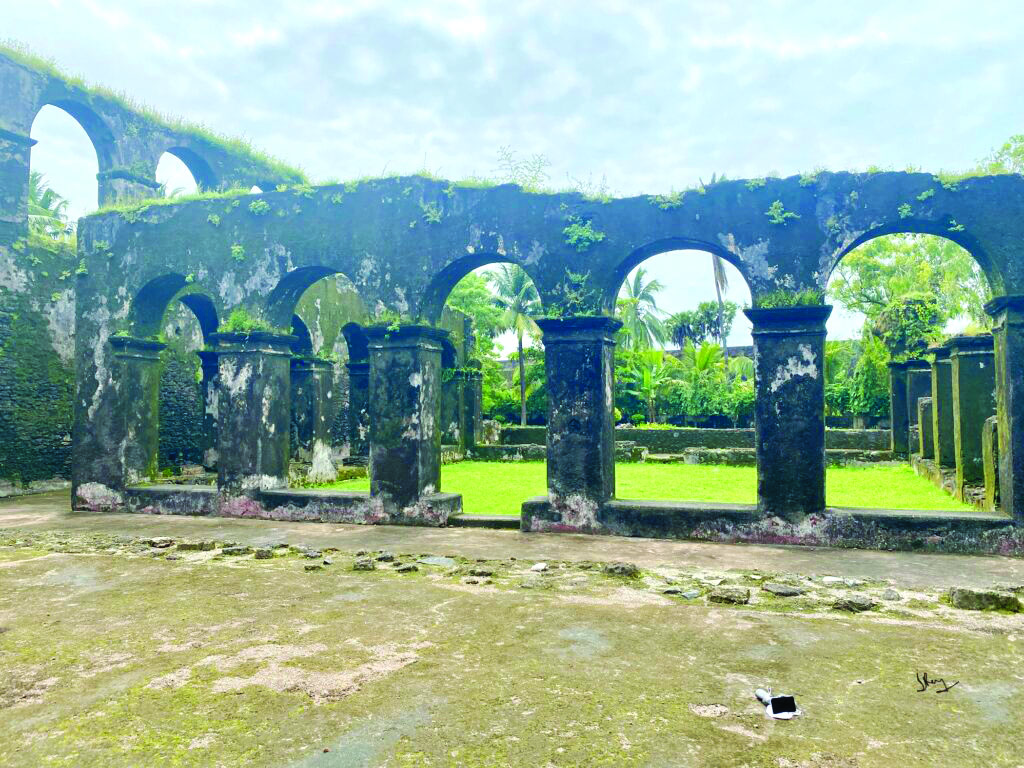 Churches of Moti Daman
Churches of Moti Daman
There are several Portuguese-era churches here, their small size indicates that they are as they were originally made for a small population. The three churches that I visited include:
Church of Bom Jesus
Church of Bom Jesus. The Church of Bom Jesus reminded me of the church by the same name in Goa. This one though is much smaller, more quainter, and more peaceful. A carved stone gateway stands out on the backdrop of a white wall that tries to touch the sky with its triangular tip.
Wood Carved interiors of the Church of Bom Jesus: The inside of the church is also simple but for the profusely wood-carved balconies. With faded but still bright blue and red colors, these carvings tell you a lot about the woodcarvers of those days and of course about their patrons. If you visit this church, do walk to the side of this church to admire another stone door, that looks just lovely through the veil of fragile branches of trees around it.
Church of Our Lady of Rosary. This simple-looking chapel is just across the garden from the Church of Bom Jesus. When I visited this chapel was closed so I could only see it from outside. A board here claims that the chapel has very ornate interiors.
Ruins of Dominican Monastery. You have to go through some narrow lanes to reach these beautiful ruins — yes, they are very beautiful. Standing in an obscure corner, with hardly anyone coming to visit them they seem to be enjoying their solitude.
In its heyday, these ruins were a Dominican monastery where catholic scholars came from all over the world. No one knows why and how it declined and why it was let to fall while most other churches in the vicinity are well maintained. My driver cum guide told me that the last activity he heard about here was the photo shoot of the Kingfisher calendar. Must admire the location hunters of Mr. Mallya.
Church of Our Lady of Remedies. This is again a church that dates back to 1607 AD and has simple white exteriors with blue borders but an ornate altar.
Jail
Between the Church of Bom Jesus and the Chapel of Our Lady of Rosary is a white building with many small windows, all of which are sealed. I asked around a bit and figured out that this was the town’s jail. No wonder the windows are all closed. No clue if the building is still in use.
Liberation Memorial
A small memorial in white and golden remembers December 1961, when it along with Goa & Diu Daman was liberated from the 400 years of Portuguese rule and merged with the Republic of India. A plaque reads ‘Daman was liberated by 1st Bn The Maratha Light Infantry on 19th Dec 1961 after a heroic fight thus ending the 450 years old Portuguese regime’.
Bocage House
This is a tourist-created ‘myth’ of the town. The room that you see next to the fort gate is called Bocage House — there is a plaque on top that confirms this. However, if you look inside, it looks like a storehouse where some building material is stored.
From its position, it could have been the place where Fort guards stayed or maybe a home. No one in the town knows why this house is what all foreign tourists come looking for. No one knows, in fact not even Google at the time of writing. I assume it must be someone mentioning it in a popular guidebook that would be sending many tourists.
Pergola Garden
The Pergola garden stands opposite the Liberation Memorial and is quite close to the gate of the fort. It is a small garden with circular seating and a rock structure in the middle. It was a rock memorial for Portuguese soldiers but after liberation, it has been converted into a garden. You can still see some memorial plaques in Portuguese on the rocks dating pre-liberation.
You can visit all these places in a day, but make it one night and two days to enjoy them perfectly.
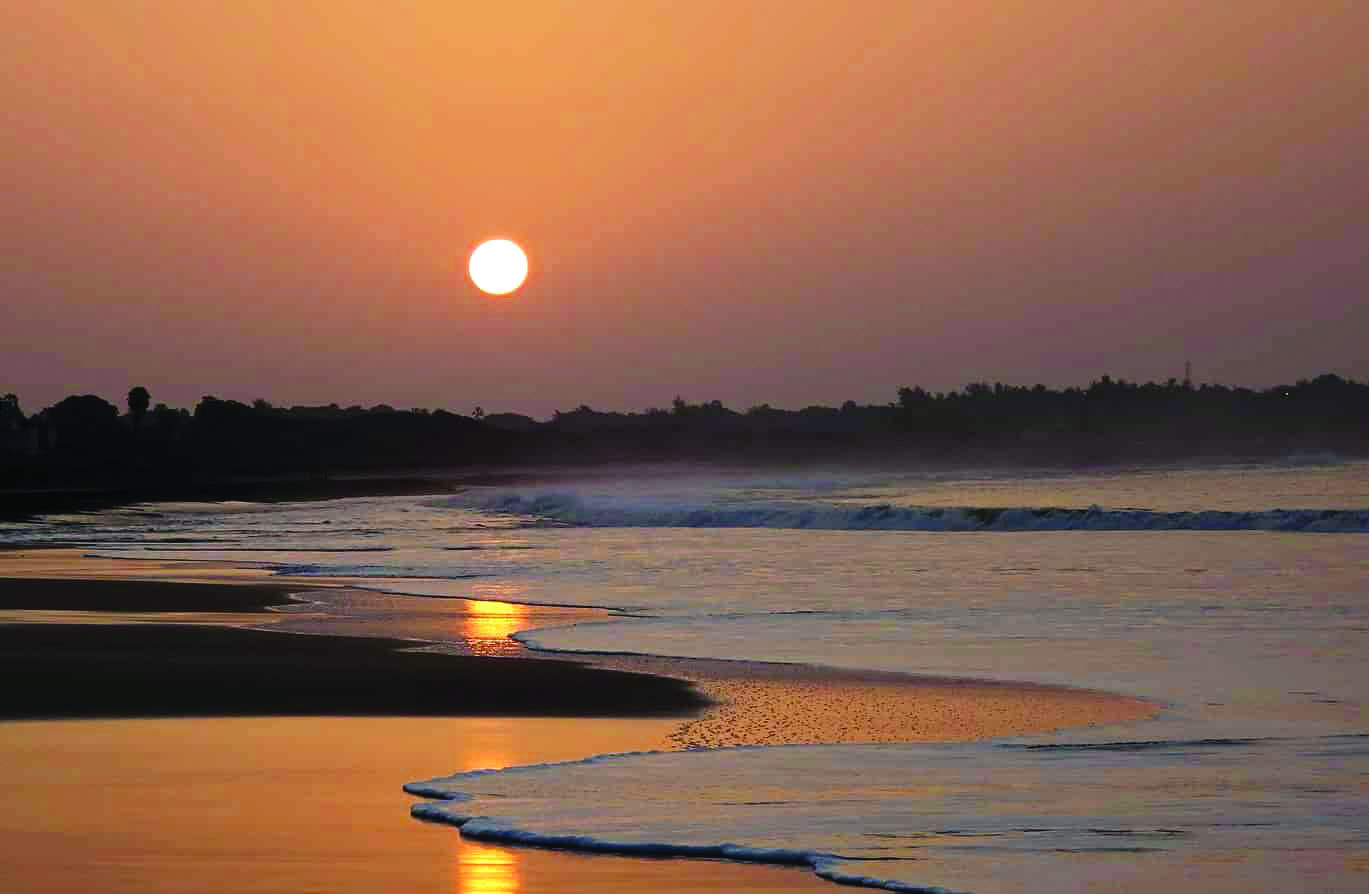 Jampore Beach
Jampore Beach
Jampore Beach is the hot spot of Daman City. Now a big part of the small Union territory of Daman & Diu, located on the west coast of India. It takes just 2-3 hours to drive from Mumbai to this city and even lesser from many cities in Gujarat such as Surat. It is a favorite getaway from these cities — when people are looking forward to a quieter place where they can enjoy a chhota peg.
This is a simple beach with dark sand and mud-colored water. The sea tide here can vary a lot — so check the tide before you go. If it is too low, the sea would be too far though you would see a lot of activity in the space it has left. If it is too high you may not have enough room for yourself.
Some interesting things you can do here include taking a camel ride, horse riding, car racing, ride an all-terrain vehicle and parasailing.
Daman has a varied range of accommodation from the luxurious five star hotels in close vicinity of the beach. Accommodation: High-end: Villa Nest (Rs.27,000 per night), Praveg Jampore Beach Resort (Rs.16,346), The Deltin Hotel (Rs.10,696); Mid-range: Daman Devka Villa (Rs.5,583), Gold Beach Villa Daman (Rs.5,580), Hotel Princess Park (Rs.4,650); Budget: Daman Home (Rs.3,383), Hotel the Emerald (Rs.2,683), Le Pension (Rs.8,52).
Getting there: Daman is 90 kms from Surat International Airport and 170 km from Chhatrapati Shivaji Maharaj International Airport, Mumbai. The nearest railway station is at Vapi, a mere 12 kms. Several Delhi-Mumbai and Mumbai-Ahmedabad trains halt here.
(Source: https://www.inditales.com/)
Also read: Andaman and Nicobar Islands: India’s islands in the sun























